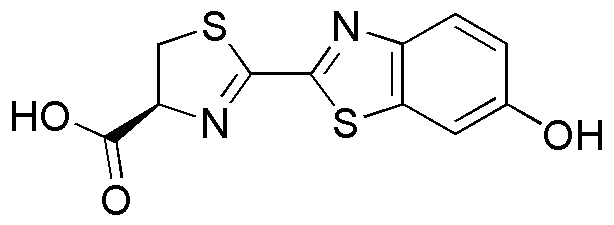D-Luciferin is widely utilized in research focused on:
- Bioluminescence Imaging: This compound is essential for in vivo imaging in biological research, allowing scientists to visualize cellular processes in real-time using light emitted from D-Luciferin when it reacts with luciferase enzymes.
- Drug Development: In pharmacology, D-Luciferin is used to monitor the efficacy of drug candidates by tracking cellular responses and metabolic activities, providing insights into drug mechanisms and effects.
- Gene Expression Studies: Researchers employ D-Luciferin in reporter assays to study gene expression, enabling the assessment of promoter activity and the effects of regulatory elements in various biological contexts.
- Environmental Monitoring: This compound is used in ecotoxicology to assess the impact of pollutants on living organisms, helping researchers understand the effects of environmental stressors on bioluminescent species.
- Pathogen Detection: D-Luciferin is utilized in assays for detecting pathogens, such as bacteria and viruses, by providing a sensitive and rapid method for identifying infectious agents in clinical and environmental samples.
Información general
Propiedades
Seguridad y normativas
Aplicaciones
D-Luciferin is widely utilized in research focused on:
- Bioluminescence Imaging: This compound is essential for in vivo imaging in biological research, allowing scientists to visualize cellular processes in real-time using light emitted from D-Luciferin when it reacts with luciferase enzymes.
- Drug Development: In pharmacology, D-Luciferin is used to monitor the efficacy of drug candidates by tracking cellular responses and metabolic activities, providing insights into drug mechanisms and effects.
- Gene Expression Studies: Researchers employ D-Luciferin in reporter assays to study gene expression, enabling the assessment of promoter activity and the effects of regulatory elements in various biological contexts.
- Environmental Monitoring: This compound is used in ecotoxicology to assess the impact of pollutants on living organisms, helping researchers understand the effects of environmental stressors on bioluminescent species.
- Pathogen Detection: D-Luciferin is utilized in assays for detecting pathogens, such as bacteria and viruses, by providing a sensitive and rapid method for identifying infectious agents in clinical and environmental samples.
Documentos
Hojas de datos de seguridad (HDS)
La SDS proporciona información de seguridad completa sobre la manipulación, el almacenamiento y la eliminación del producto.
Especificación del producto (PS)
La PS proporciona un desglose completo de las propiedades del producto, incluida la composición química, el estado físico, la pureza y los requisitos de almacenamiento. También detalla los rangos de calidad aceptables y las aplicaciones previstas del producto.
Certificados de análisis (COA)
Busque certificados de análisis (COA) ingresando el número de lote del producto. Los números de lote y de partida se pueden encontrar en la etiqueta de un producto después de las palabras "Lote" o "Lote".
Número de catálogo
Número de lote/lote
Certificados de origen (COO)
Este certificado de origen confirma el país en el que se fabricó el producto y también detalla los materiales y componentes utilizados en él y si se deriva de fuentes naturales, sintéticas u otras fuentes específicas. Este certificado puede ser necesario para cumplir con las normativas aduaneras, comerciales y regulatorias.
Número de catálogo
Número de lote/lote
Hojas de datos de seguridad (HDS)
La SDS proporciona información de seguridad completa sobre la manipulación, el almacenamiento y la eliminación del producto.
DownloadEspecificación del producto (PS)
La PS proporciona un desglose completo de las propiedades del producto, incluida la composición química, el estado físico, la pureza y los requisitos de almacenamiento. También detalla los rangos de calidad aceptables y las aplicaciones previstas del producto.
DownloadCertificados de análisis (COA)
Busque certificados de análisis (COA) ingresando el número de lote del producto. Los números de lote y de partida se pueden encontrar en la etiqueta de un producto después de las palabras "Lote" o "Lote".
Número de catálogo
Número de lote/lote
Certificados de origen (COO)
Este certificado de origen confirma el país en el que se fabricó el producto y también detalla los materiales y componentes utilizados en él y si se deriva de fuentes naturales, sintéticas u otras fuentes específicas. Este certificado puede ser necesario para cumplir con las normativas aduaneras, comerciales y regulatorias.

